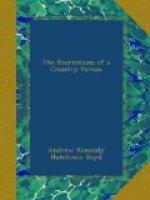No, no; the thing will never do!
One of the latest examples of burning, in the case of a Christian, is that of Henry Laurens, the first President of the American Congress. In his will he solemnly enjoined upon his children that they should cause his body to be given to the flames. The Emperor Napoleon, when at St. Helena, expressed a similar desire; and said, truly enough, that as for the Resurrection, that would be miraculous at all events, and it would be just as easy for the Almighty to accomplish that great end in the case of burning as in that of burial. And, indeed, the doctrine of the Resurrection is one that it is not wise to scrutinize too minutely—I mean as regards its rationale. It is best to simply hold by the great truth, that ’this corruptible shall put on incorruption, and this mortal shall put on immortality.’ I presume that it has been shown beyond doubt that the material particles which make up our bodies are in a state of constant flux, the entire physical nature being changed every seven years, so that if all the particles which once entered into the structure of a man of fourscore were reassembled, they would suffice to make seven or eight bodies. And the manner in which it is certain that the mortal part of man is dispersed and assimilated to all the elements furnishes a very striking thought. Bryant has said, truly and beautifully,
All
that tread
The globe, are but a handful
to the tribes
That slumber in its bosom.
And James Montgomery, in a poem of his which is little known, and which is amplified and spoiled in the latest editions of his works, has suggested to us whither the mortal vestiges of these untold millions have gone. It is entitled Lines to a Molehill in a Churchyard.
Tell me, thou dust beneath
my feet,—
Thou
dust that once hadst breath,—
Tell me, how many mortals
meet
In
this small hill of death.
The mole, that scoops with
curious toil
Her
subterranean bed,
Thinks not she plows a human
soil,
And
mines among the dead.
Yet, whereso’er she
turns the ground,
My
kindred earth I see:
Once every atom of this mound
Lived,
breathed, and felt, like me.
Through all this hillock’s
crumbling mould
Once
the warm lifeblood ran:
Here thine original behold,
And
here thy ruins, man!
By wafting winds and flooding
rains,
From
ocean, earth, and sky,
Collected here, the frail
remains
Of
slumbering millions lie.
The towers and temples crushed
by time,
Stupendous
wrecks, appear
To me less mournfully sublime
Than
this poor molehill here.
Methinks this dust yet heaves
with breath—
Ten
thousand pulses beat;—
Tell me, in this small hill
of death,
How
many mortals meet!




